Lookalike Disambiguation: Improving Face Identification Performance at Top Ranks
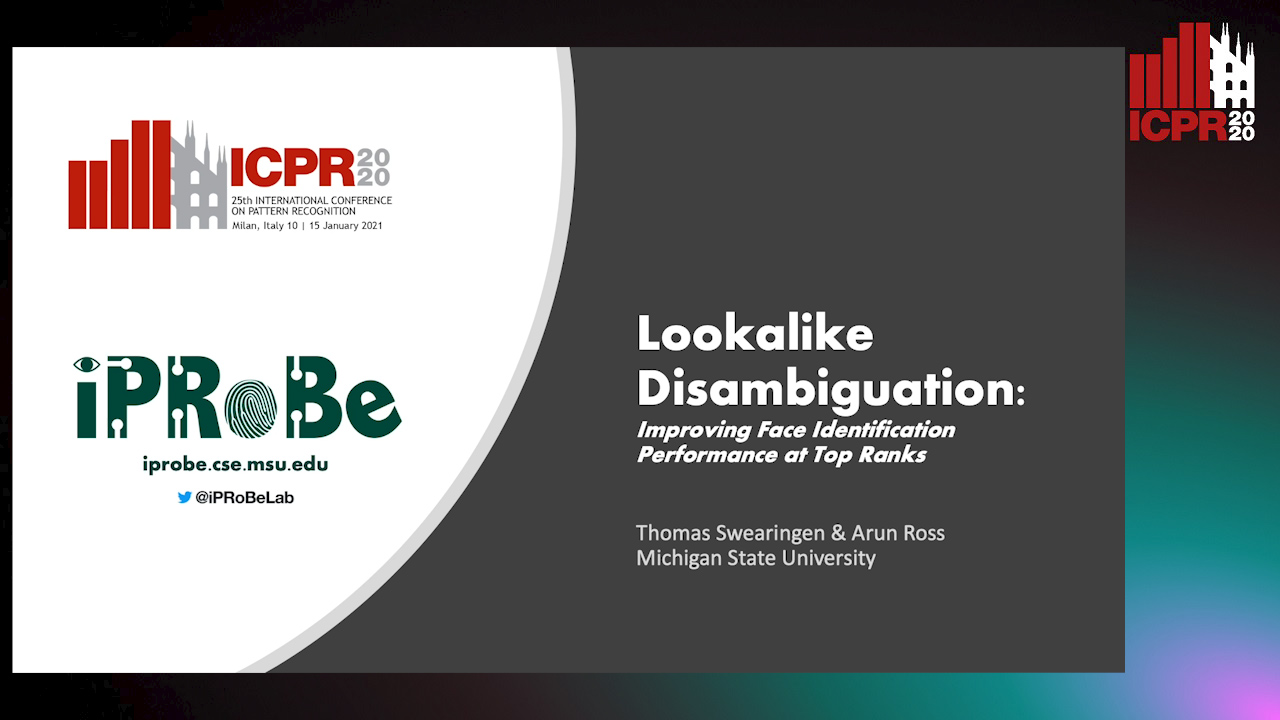
Auto-TLDR; Lookalike Face Identification Using a Disambiguator for Lookalike Images
Similar papers
Identifying Missing Children: Face Age-Progression Via Deep Feature Aging
Debayan Deb, Divyansh Aggarwal, Anil Jain

Auto-TLDR; Aging Face Features for Missing Children Identification
One-Shot Representational Learning for Joint Biometric and Device Authentication

Auto-TLDR; Joint Biometric and Device Recognition from a Single Biometric Image
Abstract Slides Poster Similar
How Unique Is a Face: An Investigative Study
Michal Balazia, S L Happy, Francois Bremond, Antitza Dantcheva
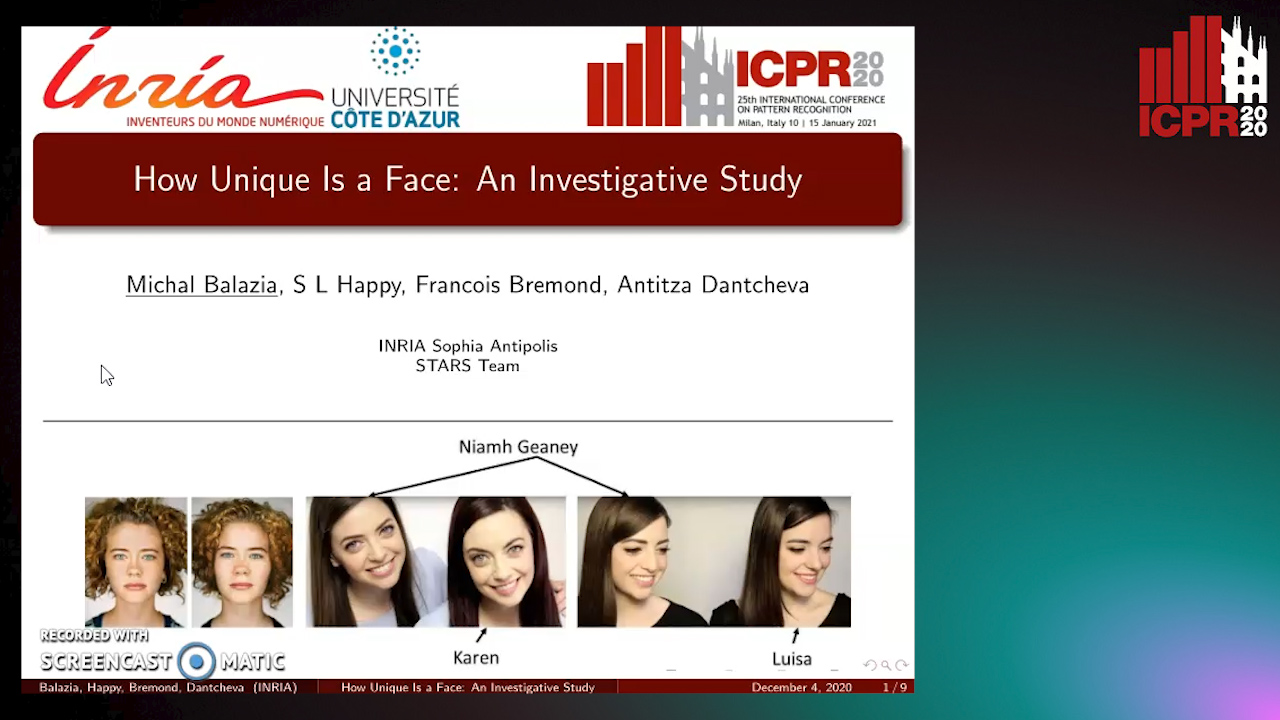
Auto-TLDR; Uniqueness of Face Recognition: Exploring the Impact of Factors such as image resolution, feature representation, database size, age and gender
Abstract Slides Poster Similar
Multi-Level Deep Learning Vehicle Re-Identification Using Ranked-Based Loss Functions
Eleni Kamenou, Jesus Martinez-Del-Rincon, Paul Miller, Patricia Devlin - Hill

Auto-TLDR; Multi-Level Re-identification Network for Vehicle Re-Identification
Abstract Slides Poster Similar
Detection of Makeup Presentation Attacks Based on Deep Face Representations
Christian Rathgeb, Pawel Drozdowski, Christoph Busch

Auto-TLDR; An Attack Detection Scheme for Face Recognition Using Makeup Presentation Attacks
Abstract Slides Poster Similar
ClusterFace: Joint Clustering and Classification for Set-Based Face Recognition
Samadhi Poornima Kumarasinghe Wickrama Arachchilage, Ebroul Izquierdo

Auto-TLDR; Joint Clustering and Classification for Face Recognition in the Wild
Abstract Slides Poster Similar
Age Gap Reducer-GAN for Recognizing Age-Separated Faces
Daksha Yadav, Naman Kohli, Mayank Vatsa, Richa Singh, Afzel Noore

Auto-TLDR; Generative Adversarial Network for Age-separated Face Recognition
Abstract Slides Poster Similar
Quality-Based Representation for Unconstrained Face Recognition
Nelson Méndez-Llanes, Katy Castillo-Rosado, Heydi Mendez-Vazquez, Massimo Tistarelli

Auto-TLDR; activation map for face recognition in unconstrained environments
3D Facial Matching by Spiral Convolutional Metric Learning and a Biometric Fusion-Net of Demographic Properties
Soha Sadat Mahdi, Nele Nauwelaers, Philip Joris, Giorgos Bouritsas, Imperial London, Sergiy Bokhnyak, Susan Walsh, Mark Shriver, Michael Bronstein, Peter Claes

Auto-TLDR; Multi-biometric Fusion for Biometric Verification using 3D Facial Mesures
Contrastive Data Learning for Facial Pose and Illumination Normalization

Auto-TLDR; Pose and Illumination Normalization with Contrast Data Learning for Face Recognition
Abstract Slides Poster Similar
SoftmaxOut Transformation-Permutation Network for Facial Template Protection
Hakyoung Lee, Cheng Yaw Low, Andrew Teoh

Auto-TLDR; SoftmaxOut Transformation-Permutation Network for C cancellable Biometrics
Abstract Slides Poster Similar
Lightweight Low-Resolution Face Recognition for Surveillance Applications
Yoanna Martínez-Díaz, Heydi Mendez-Vazquez, Luis S. Luevano, Leonardo Chang, Miguel Gonzalez-Mendoza

Auto-TLDR; Efficiency of Lightweight Deep Face Networks on Low-Resolution Surveillance Imagery
Abstract Slides Poster Similar
Face Image Quality Assessment for Model and Human Perception
Ken Chen, Yichao Wu, Zhenmao Li, Yudong Wu, Ding Liang

Auto-TLDR; A labour-saving method for FIQA training with contradictory data from multiple sources
Abstract Slides Poster Similar
Learning Disentangled Representations for Identity Preserving Surveillance Face Camouflage
Jingzhi Li, Lutong Han, Hua Zhang, Xiaoguang Han, Jingguo Ge, Xiaochu Cao

Auto-TLDR; Individual Face Privacy under Surveillance Scenario with Multi-task Loss Function
Open-World Group Retrieval with Ambiguity Removal: A Benchmark
Ling Mei, Jian-Huang Lai, Zhanxiang Feng, Xiaohua Xie
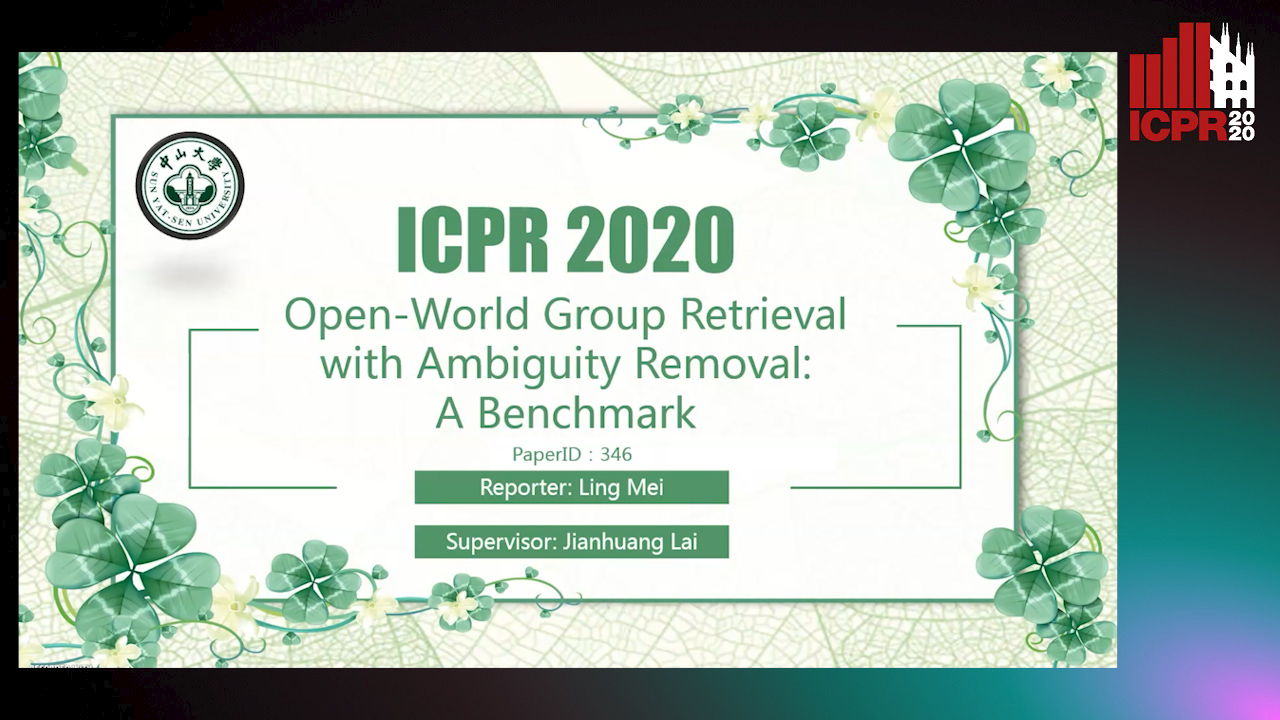
Auto-TLDR; P2GSM-AR: Re-identifying changing groups of people under the open-world and group-ambiguity scenarios
Abstract Slides Poster Similar
Unsupervised Disentangling of Viewpoint and Residues Variations by Substituting Representations for Robust Face Recognition
Minsu Kim, Joanna Hong, Junho Kim, Hong Joo Lee, Yong Man Ro

Auto-TLDR; Unsupervised Disentangling of Identity, viewpoint, and Residue Representations for Robust Face Recognition
Abstract Slides Poster Similar
Deep Top-Rank Counter Metric for Person Re-Identification
Chen Chen, Hao Dou, Xiyuan Hu, Silong Peng

Auto-TLDR; Deep Top-Rank Counter Metric for Person Re-identification
Abstract Slides Poster Similar
Sample-Dependent Distance for 1 : N Identification Via Discriminative Feature Selection
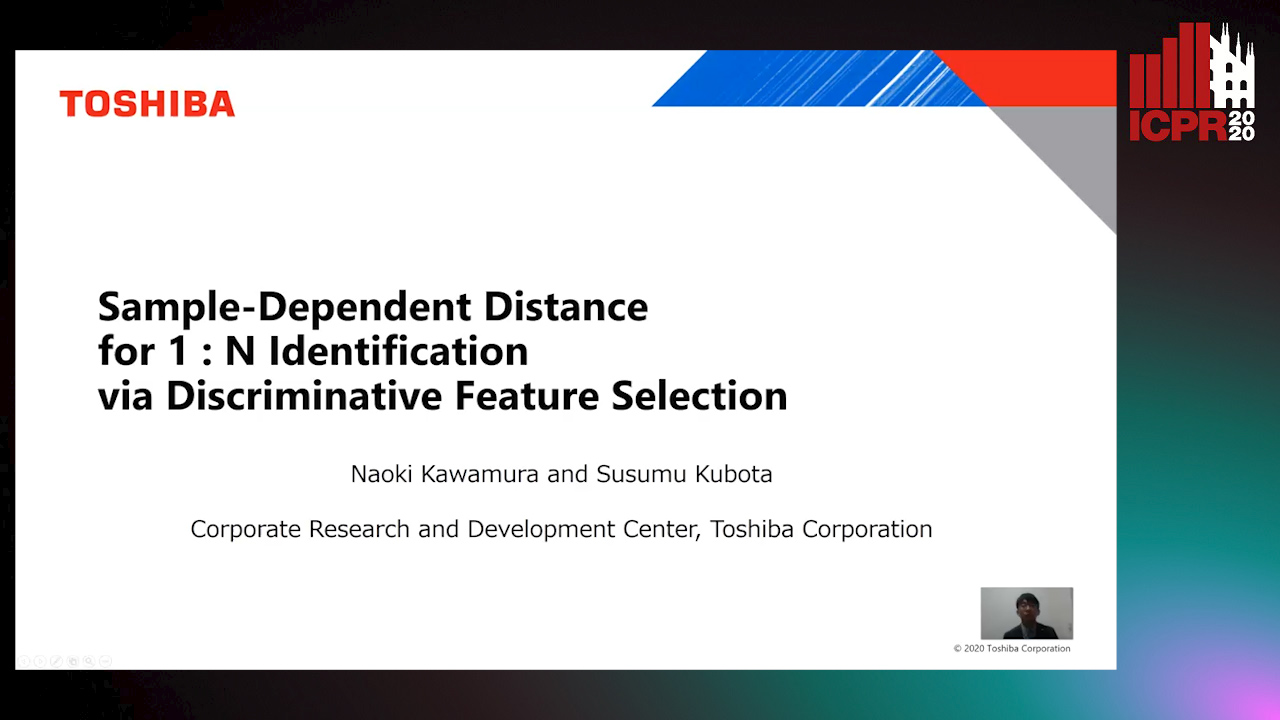
Auto-TLDR; Feature Selection Mask for 1:N Identification Problems with Binary Features
Abstract Slides Poster Similar
An Adaptive Video-To-Video Face Identification System Based on Self-Training
Eric Lopez-Lopez, Carlos V. Regueiro, Xosé M. Pardo

Auto-TLDR; Adaptive Video-to-Video Face Recognition using Dynamic Ensembles of SVM's
Abstract Slides Poster Similar
SSDL: Self-Supervised Domain Learning for Improved Face Recognition
Samadhi Poornima Kumarasinghe Wickrama Arachchilage, Ebroul Izquierdo

Auto-TLDR; Self-supervised Domain Learning for Face Recognition in unconstrained environments
Abstract Slides Poster Similar
Online Domain Adaptation for Person Re-Identification with a Human in the Loop
Rita Delussu, Lorenzo Putzu, Giorgio Fumera, Fabio Roli

Auto-TLDR; Human-in-the-loop for Person Re-Identification in Infeasible Applications
Abstract Slides Poster Similar
Attentive Part-Aware Networks for Partial Person Re-Identification
Lijuan Huo, Chunfeng Song, Zhengyi Liu, Zhaoxiang Zhang

Auto-TLDR; Part-Aware Learning for Partial Person Re-identification
Abstract Slides Poster Similar
Adaptive L2 Regularization in Person Re-Identification
Xingyang Ni, Liang Fang, Heikki Juhani Huttunen

Auto-TLDR; AdaptiveReID: Adaptive L2 Regularization for Person Re-identification
Abstract Slides Poster Similar
Attribute-Based Quality Assessment for Demographic Estimation in Face Videos
Fabiola Becerra-Riera, Annette Morales-González, Heydi Mendez-Vazquez, Jean-Luc Dugelay

Auto-TLDR; Facial Demographic Estimation in Video Scenarios Using Quality Assessment
SATGAN: Augmenting Age Biased Dataset for Cross-Age Face Recognition
Wenshuang Liu, Wenting Chen, Yuanlue Zhu, Linlin Shen

Auto-TLDR; SATGAN: Stable Age Translation GAN for Cross-Age Face Recognition
Abstract Slides Poster Similar
G-FAN: Graph-Based Feature Aggregation Network for Video Face Recognition
He Zhao, Yongjie Shi, Xin Tong, Jingsi Wen, Xianghua Ying, Jinshi Hongbin Zha

Auto-TLDR; Graph-based Feature Aggregation Network for Video Face Recognition
Abstract Slides Poster Similar
Cam-Softmax for Discriminative Deep Feature Learning
Tamas Suveges, Stephen James Mckenna

Auto-TLDR; Cam-Softmax: A Generalisation of Activations and Softmax for Deep Feature Spaces
Abstract Slides Poster Similar
Cross-spectrum Face Recognition Using Subspace Projection Hashing
Hanrui Wang, Xingbo Dong, Jin Zhe, Jean-Luc Dugelay, Massimo Tistarelli

Auto-TLDR; Subspace Projection Hashing for Cross-Spectrum Face Recognition
Abstract Slides Poster Similar
DAIL: Dataset-Aware and Invariant Learning for Face Recognition
Gaoang Wang, Chen Lin, Tianqiang Liu, Mingwei He, Jiebo Luo

Auto-TLDR; DAIL: Dataset-Aware and Invariant Learning for Face Recognition
Abstract Slides Poster Similar
Progressive Learning Algorithm for Efficient Person Re-Identification
Zhen Li, Hanyang Shao, Liang Niu, Nian Xue

Auto-TLDR; Progressive Learning Algorithm for Large-Scale Person Re-Identification
Abstract Slides Poster Similar
Optimal Strategies for Comparing Covariates to Solve Matching Problems
Muhammad Ahmed Shah, Raphael Olivier, Bhiksha Raj

Auto-TLDR; Covariate Matching for Pairwise Verification and Ranking
Abstract Slides Poster Similar
Finger Vein Recognition and Intra-Subject Similarity Evaluation of Finger Veins Using the CNN Triplet Loss
Georg Wimmer, Bernhard Prommegger, Andreas Uhl

Auto-TLDR; Finger vein recognition using CNNs and hard triplet online selection
Abstract Slides Poster Similar
How Important Are Faces for Person Re-Identification?
Julia Dietlmeier, Joseph Antony, Kevin Mcguinness, Noel E O'Connor

Auto-TLDR; Anonymization of Person Re-identification Datasets with Face Detection and Blurring
Abstract Slides Poster Similar
Angular Sparsemax for Face Recognition
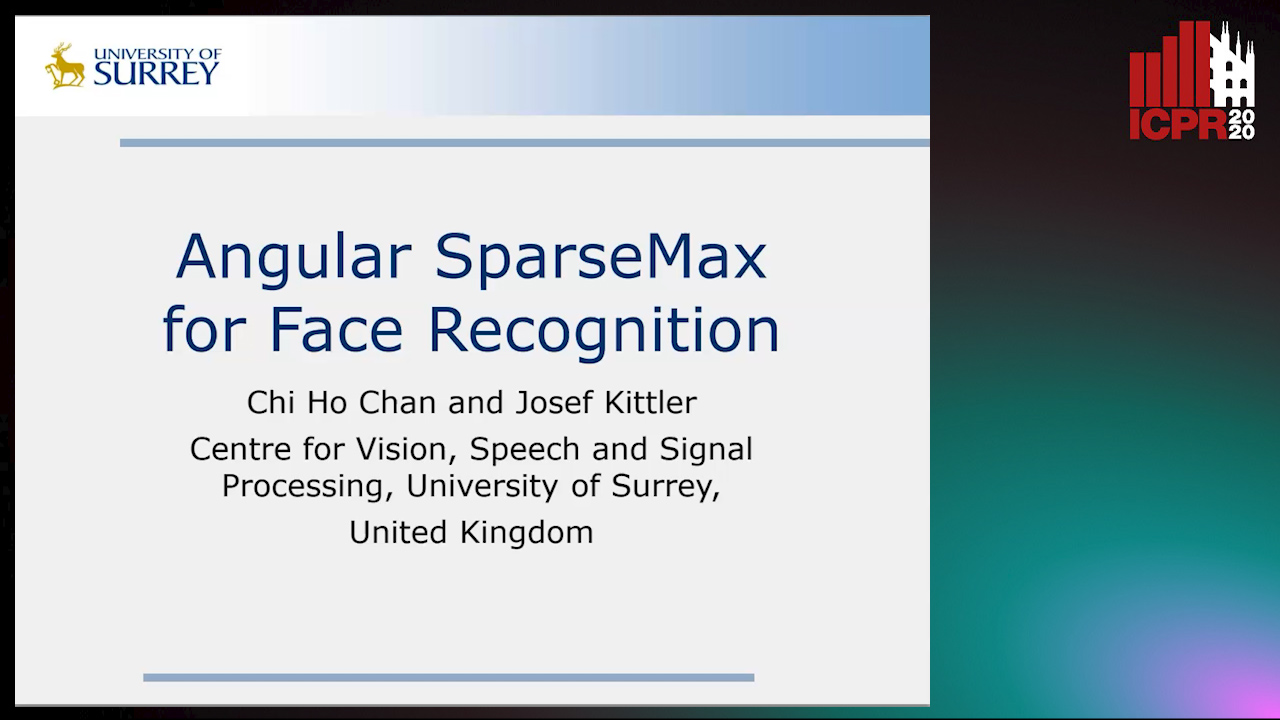
Auto-TLDR; Angular Sparsemax for Face Recognition
Abstract Slides Poster Similar
Pose-Robust Face Recognition by Deep Meta Capsule Network-Based Equivariant Embedding
Fangyu Wu, Jeremy Simon Smith, Wenjin Lu, Bailing Zhang

Auto-TLDR; Deep Meta Capsule Network-based Equivariant Embedding Model for Pose-Robust Face Recognition
Rethinking ReID:Multi-Feature Fusion Person Re-Identification Based on Orientation Constraints
Mingjing Ai, Guozhi Shan, Bo Liu, Tianyang Liu

Auto-TLDR; Person Re-identification with Orientation Constrained Network
Abstract Slides Poster Similar
Learning Emotional Blinded Face Representations
Alejandro Peña Almansa, Julian Fierrez, Agata Lapedriza, Aythami Morales

Auto-TLDR; Blind Face Representations for Emotion Recognition
Abstract Slides Poster Similar
Loop-closure detection by LiDAR scan re-identification
Jukka Peltomäki, Xingyang Ni, Jussi Puura, Joni-Kristian Kamarainen, Heikki Juhani Huttunen

Auto-TLDR; Loop-Closing Detection from LiDAR Scans Using Convolutional Neural Networks
Abstract Slides Poster Similar
Top-DB-Net: Top DropBlock for Activation Enhancement in Person Re-Identification

Auto-TLDR; Top-DB-Net for Person Re-Identification using Top DropBlock
Abstract Slides Poster Similar
A Flatter Loss for Bias Mitigation in Cross-Dataset Facial Age Estimation
Ali Akbari, Muhammad Awais, Zhenhua Feng, Ammarah Farooq, Josef Kittler

Auto-TLDR; Cross-dataset Age Estimation for Neural Network Training
Abstract Slides Poster Similar
3D Dental Biometrics: Automatic Pose-Invariant Dental Arch Extraction and Matching
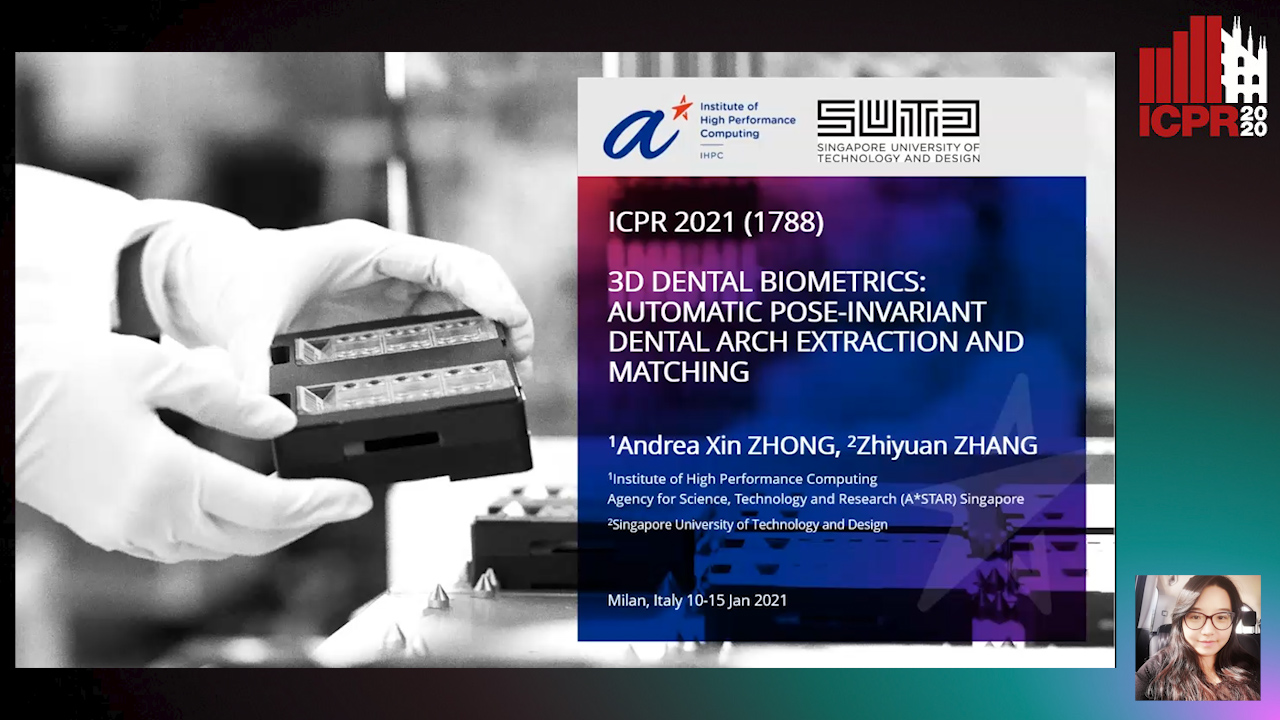
Auto-TLDR; Automatic Dental Arch Extraction and Matching for 3D Dental Identification using Laser-Scanned Plasters
Abstract Slides Poster Similar
InsideBias: Measuring Bias in Deep Networks and Application to Face Gender Biometrics
Ignacio Serna, Alejandro Peña Almansa, Aythami Morales, Julian Fierrez

Auto-TLDR; InsideBias: Detecting Bias in Deep Neural Networks from Face Images
Abstract Slides Poster Similar
Deep Gait Relative Attribute Using a Signed Quadratic Contrastive Loss
Yuta Hayashi, Shehata Allam, Yasushi Makihara, Daigo Muramatsu, Yasushi Yagi

Auto-TLDR; Signal-Contrastive Loss for Gait Attributes Estimation
Nonlinear Ranking Loss on Riemannian Potato Embedding
Byung Hyung Kim, Yoonje Suh, Honggu Lee, Sungho Jo

Auto-TLDR; Riemannian Potato for Rank-based Metric Learning
Abstract Slides Poster Similar
Equation Attention Relationship Network (EARN) : A Geometric Deep Metric Framework for Learning Similar Math Expression Embedding
Saleem Ahmed, Kenny Davila, Srirangaraj Setlur, Venu Govindaraju

Auto-TLDR; Representational Learning for Similarity Based Retrieval of Mathematical Expressions
Abstract Slides Poster Similar
Not 3D Re-ID: Simple Single Stream 2D Convolution for Robust Video Re-Identification

Auto-TLDR; ResNet50-IBN for Video-based Person Re-Identification using Single Stream 2D Convolution Network
Abstract Slides Poster Similar
Generalized Local Attention Pooling for Deep Metric Learning
Carlos Roig Mari, David Varas, Issey Masuda, Juan Carlos Riveiro, Elisenda Bou-Balust

Auto-TLDR; Generalized Local Attention Pooling for Deep Metric Learning
Abstract Slides Poster Similar
Exemplar Guided Cross-Spectral Face Hallucination Via Mutual Information Disentanglement
Haoxue Wu, Huaibo Huang, Aijing Yu, Jie Cao, Zhen Lei, Ran He

Auto-TLDR; Exemplar Guided Cross-Spectral Face Hallucination with Structural Representation Learning
Abstract Slides Poster Similar